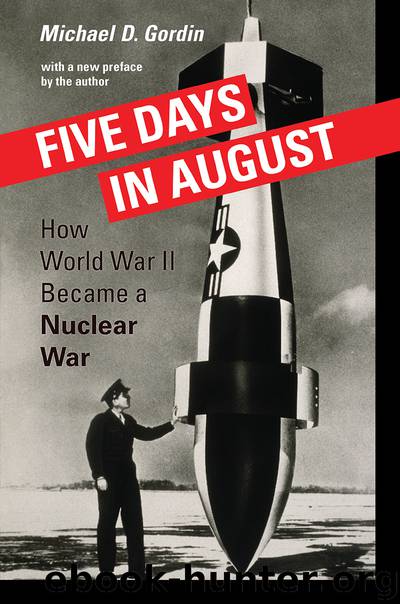Five Days in August by Michael D. Gordin

Author:Michael D. Gordin
Language: eng
Format: epub
Publisher: Princeton University Press
Published: 2015-03-10T16:00:00+00:00
Chapter 7
Beginnings
THE TRANSFORMATION OF NUCLEAR WEAPONS from tactical ordnance delivered from Tinian conventionally and repeatedly into their contemporary role as stand-ins for the Horsemen of the Apocalypse turns out to be more than a historical curiosity. Both the process by which this elevation of atomic bombs took place and its final result began to structure multiple features of the Cold War. Unlike many of the guiding precepts of Cold War diplomacy that now lie discarded, “nuclearism”—the attitude toward strategy, tactics, and politics that builds on the notion of nuclear bombs as “absolute weapons”—has outlived its Soviet-American incubation period and retained a dominating force in the contemporary world. The image formed in those days of late August 1945, shaped by William Laurence and proselytized by scientists, journalists, and politicians, is still very much with us. The point is not whether nuclearism has shaped how individuals the world over view these weapons, but how it has done so. In both the United States and Japan, in particular, the sudden end of World War II inscribed nuclear weapons as the symbols of our modern age and as the key to unlocking both past and future. That this was not inevitably built into the hardware of the weapons does not make its power any less real.
In this final chapter, some of the legacies of this way of thinking about atomic warfare will be traced out. In exploring three specific areas—the creation out of nowhere of the discipline of nuclear strategy, the development of thermonuclear weapons and the ensuing arms race between the United States and the Soviet Union, and the abiding failure of segments of the Japanese polity to acknowledge responsibility for atrocities committed in the Second World War—one finds the fingerprints of the concept of nuclear weapons as “special.” Because these bombs, and only these bombs, carry a unique aura of inviolability, they have deeply shaped considerations of the morality of nuclear warfare as well; each of the three areas just mentioned, in fact, is upon inspection to some degree concerned with the moral valences of atomic warfare. Given the preceding account of how atomic weapons came to acquire their aura, certain dilemmas and paradoxes of the nuclear age can be seen in a fresh light. It is the manifest goal of this chapter, and this book, to so illuminate them.
The first instance of this lasting legacy can be seen at the very core of the arms race that characterized the half-century of the Cold War. The discourse and doctrines of nuclear strategy remain some of the most distinctive aspects of the imagined nuclear universe. As embodied in figures like Stanley Kubrick’s Dr. Strangelove, the doctrines of how to calculate and plan for a global nuclear war were both easy to parody and in deadly earnest about the implications of living on a planet occupied by two atomic antagonists. Of course, it stands to reason that if both the United States and the Soviet Union possessed thousands of nuclear missiles that could reach
Download
This site does not store any files on its server. We only index and link to content provided by other sites. Please contact the content providers to delete copyright contents if any and email us, we'll remove relevant links or contents immediately.
| Automotive | Engineering |
| Transportation |
Whiskies Galore by Ian Buxton(41879)
Introduction to Aircraft Design (Cambridge Aerospace Series) by John P. Fielding(33064)
Small Unmanned Fixed-wing Aircraft Design by Andrew J. Keane Andras Sobester James P. Scanlan & András Sóbester & James P. Scanlan(32743)
Craft Beer for the Homebrewer by Michael Agnew(18140)
Turbulence by E. J. Noyes(7936)
The Complete Stick Figure Physics Tutorials by Allen Sarah(7307)
Kaplan MCAT General Chemistry Review by Kaplan(6867)
The Thirst by Nesbo Jo(6828)
Bad Blood by John Carreyrou(6552)
Modelling of Convective Heat and Mass Transfer in Rotating Flows by Igor V. Shevchuk(6391)
Learning SQL by Alan Beaulieu(6211)
Weapons of Math Destruction by Cathy O'Neil(6146)
Man-made Catastrophes and Risk Information Concealment by Dmitry Chernov & Didier Sornette(5921)
Digital Minimalism by Cal Newport;(5664)
Life 3.0: Being Human in the Age of Artificial Intelligence by Tegmark Max(5474)
iGen by Jean M. Twenge(5366)
Secrets of Antigravity Propulsion: Tesla, UFOs, and Classified Aerospace Technology by Ph.D. Paul A. Laviolette(5309)
Design of Trajectory Optimization Approach for Space Maneuver Vehicle Skip Entry Problems by Runqi Chai & Al Savvaris & Antonios Tsourdos & Senchun Chai(5011)
Pale Blue Dot by Carl Sagan(4912)
